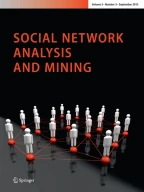Abstract
Consider an undirected and unweighted graph \(G=(V,E)\) where V is the set of vertices and E is the set of edges. Let P be a set of pairs of vertices in G. For a given integer k, we assume that there exists at least k edge disjoint paths between pairs of vertices in P. We consider a new problem that studies the role played by each edge in G to maintain at least k edge disjoint paths between pairs of vertices in P. Hereafter, we refer to this as pairwise k-edge connectivity problem. We compute the Banzhaf power index of each edge to tackle pairwise k-edge connectivity problem that determines the value that edge plays in establishing at least k edge disjoint paths between vertex pairs in P. In particular, we show that computing the Banzhaf power indices of the edges for pairwise k-edge connectivity is \(\#P\)-complete. We also derive a closed form expression for the Banzhaf power index in the k-edge connectivity problem when the graph is a tree.
Similar content being viewed by others
References
Adamic L, Adar E (2003) Friends and neighbors on the web. Soc Netw 25(3):211–230
Al Hasan M, Zaki M (2011) Link prediction in social networks. In: Chapter in social network data analytics book
Almgren K, Lee J (2016) An empirical comparison of influence measurements for social network analysis. Soc Netw Anal Min 6:52
Banzhaf JF (1965) Weighted voting doesn’t work: a mathematical analysis. Rutgers Law Rev 19(2):317–343
Budak C, Agrawal D, Abbadi AE (2011) Limiting the spread of misinformation in social networks. In: Proceedings of the 20th international conference on world wide web, (WWW), pp 665–674
Ghawi R, Petz C, Pfeffer J (2021) Diffusion dynamics of influence in a social network of intellectuals. Soc Netw Anal Min 11:63
Hasani-Mavriqi I, Geigl F, Pujari SC et al (2016) The influence of social status and network structure on consensus building in collaboration networks. Soc Anal Min 6:80
Jackson MO (2008) Social and economic networks. Princeton University Press, Princeton
Leskovec J, Adamic LA, Huberman BA (2007) The dynamics of viral marketing. ACM Trans Web (TWEB) 1(1)
Rogers EM (1962) Diffusion of innovations. Free Press, New York
Valiant LG (1979a) The complexity of enumeration and reliability problems. SIAM J Comput 8:410–421
Valiant LG (1979b) The complexity of computing the permanent. Theor Comput Sci 8(2):189–201
Wang X, Deng K, Li J, Xu YJ, Jensen CS, Yang X (2020) Efficient targeted influence minimization in big social networks. World Wide Web 23(4):2323–2340
West DB (1999) Introduction to graph theory, 2nd edn. Prentice Hall, New York
Zhang H, Zhang H, Li X, Thai MT (2015) Limiting the spread of misinformation while effectively raising awareness in social networks. In: Proceedings of CSoNet, pp 35–47
Author information
Authors and Affiliations
Corresponding author
Ethics declarations
Ethical approval
This article does not contain any studies with human participants or animals performed by any of the authors.
Rights and permissions
Springer Nature or its licensor (e.g. a society or other partner) holds exclusive rights to this article under a publishing agreement with the author(s) or other rightsholder(s); author self-archiving of the accepted manuscript version of this article is solely governed by the terms of such publishing agreement and applicable law.
About this article
Cite this article
Narayanam, L.S.V., Motammanavar, S.V. On computing Banzhaf power index for k-edge connectivity in graphs. Soc. Netw. Anal. Min. 12, 160 (2022). https://doi.org/10.1007/s13278-022-00985-7
Received:
Revised:
Accepted:
Published:
DOI: https://doi.org/10.1007/s13278-022-00985-7
